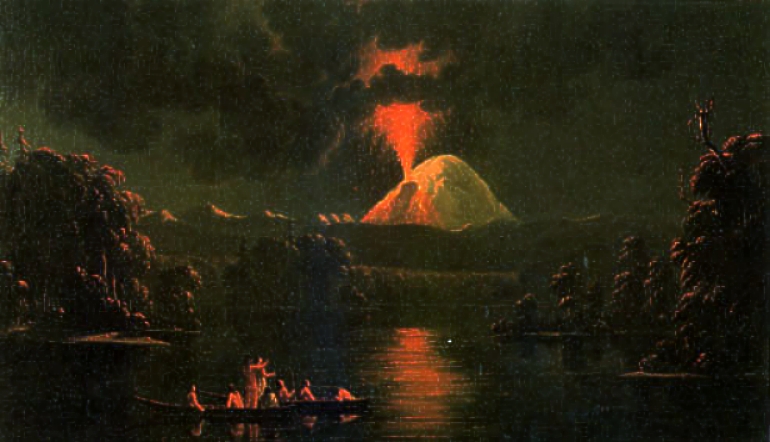I’m fairly certain Paul Kane didn’t expect to paint an active volcano when he went West. He was interested in Native Americans. The Hudson Bay Company almost didn’t send him so far, either: they thought the Irish-born Canadian might not be tough enough for the American West, so they adopted a wait-and-see attitude. Make it thus far, they said, and you can go further.

He laughed in the face of hardship and made it all the way. “The greatest hardship that I had to endure,” he later wrote, “was the difficulty in trying to sleep in a civilized bed.” Traveling over the Rockies, through what would become Oregon and Washington, and back again, in a time before abundant railroads and hotels, crossing mountains by snowshoe because the horses couldn’t make it through deep snow, facing the possibility of attack by hostile tribes, certainly adapts a person to things other than feather beds.
Yeah. He was tough enough.
He got his Native American sketches, later turned into paintings, which are still a boon to ethnologists. And he brought back a little something special for geologists. In fact, his contribution to the field is given special mention in Dwight Crandell’s exquisitely-detailed paper on Mount St. Helens’s eruptive history, “Deposits of Pre-1980 Pyroclastic Flows and Lahars from Mount St. Helens Volcano, Washington.”
Several eyewitness accounts cite some kind of eruptive activity occurring on the northwest or north side of Mount St. Helens during the 1840’s and 1850’s. Of these accounts, the best documentation is a painting by the Canadian artist Paul Kane, which was based on a sketch he made in March 1847. The painting shows an eruption column rising above a vent on the northwest side of the volcano in the approximate position of Goat Rocks. The start of dome extrusion has not been determined. I infer that the eyewitness accounts and Kane’s painting record dome extrusion over a period of many years, intermittently accompanied by emission of ash, steam, and gases which were visible for great distances.
I love the merging of art and science right there. I like to imagine Paul would have got a kick out of it, too. He probably didn’t expect fame in the geological world when he sketched and later painted St. Helens’s antics.

He was fortunate enough to arrive in the Northwest during the Goat Rocks Eruptive Period, which ran from 1800 to 1857. In his notebooks, Paul recorded the nighttime eruption he would, with a little poetic license, make famous.
March 25th. – I started from the Fort for Vancouver’s Island in a small wooden canoe, with a couple of Indians, and encamped at the mouth of the Walhamette.
March 28th. – When we arrived at the mouth of the Kattlepoutal River, twenty-six miles from Fort Vancouver, I stopped to make a sketch of the volcano, Mount St. Helen’s, distant, I suppose, about thirty or forty miles. This mountain has never been visited by either Whites or Indians; the latter assert that it is inhabited by a race of beings of a different species, who are cannibals, and whom they hold in great dread; they also say that there is a lake at its base with a very extraordinary kind of fish in it, with a head more resembling that of a bear than any other animal. These superstitions are taken from the statement of a man who, they say, went to the mountain with another, and escaped the fate of his companion, who was eaten by the ” Skoocooms,” or evil genii. I offered a considerable bribe to any Indian who would accompany me in its exploration, but could not find one hardy enough to venture. It is of very great height, and being eternally covered with snow, is seen at a great distance. There was not a cloud visible in the sky at the time I commenced my sketch, and not a breath of air was perceptible: suddenly a stream of white smoke shot up from the crater of the mountain, and hovered a short time over its summit; it then settled down like a cap. This shape it retained for about an hour and a-half, and then gradually disappeared.
About three years before this the mountain was in a violent state of irruption for three or four days, and threw up burning stones and lava to an immense height, which ran in burning torrents down its snow-clad sides.
That night, he nearly caused an eruption of his own when his expedition’s campfire set a burial ground on fire. This may have briefly proved more exciting than the volcano.
Two days later, Mount St. Helens put on an encore:
March 30th – We landed at the Cowlitz farm, which belongs to the Hudson’s Bay Company. Large quantities of wheat are raised at this place. I had a fine view of Mount St. Helen’s throwing up a long column of dark smoke into the clear blue sky.
Paul sketched her, then painted her when he returned to the agonies of a civilized bed. He was the first artist known to capture a Cascades volcano in action, and remained the only for nearly 70 years. Quite the claim to geological fame, that, and all because an Irish-born Canadian wanted to document the lives of Native Americans before their way of life was gone forever. Funny how things work out.


Very cool!
A person should learn something every day, and I just did.
Thanks!